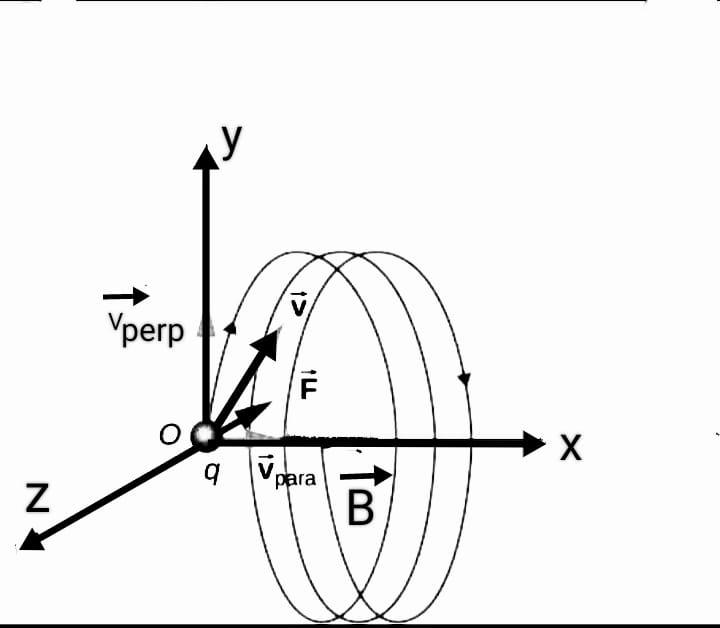
An electron is projected along the axis of a circular conductor carrying some current. The electron will experience force
A. Along the axis
B. Perpendicular to the axis
C. At an angle ${{4}^{o}}$to the axis
D. No force experienced
Answer
217.8k+ views
Hint: When an electron is projected with a uniform velocity along the axis of a circular conductor, then the electron experiences magnetic force perpendicularly to the magnetic field. But whether the charged particle will experience magnetic force or not depends on the direction of projection of the charged particle relative to the magnetic field.
Complete answer:
Whenever a circular current-carrying conductor is placed in a uniform magnetic field, the electron experiences a magnetic force in a perpendicular direction to the current and magnetic field. But if an electron moves along the axis of the circular conductor, the velocity vector is parallel to the magnetic field vector. In that case, the magnetic force experienced by the electron is zero.

Let an electron with charge $q$ projecting with a velocity $\vec{v}$ along the axis of a circular conductor in a magnetic field $\vec{B}$ is given by the following expression,
$\vec{F}=q(\vec{B}\times \vec{v})$ ……..(i)
Or,$F=qBv\sin \theta $ [Since $\theta $ is the angle between $\vec{B}$ and $\vec{v}$]
As the velocity of the particle, $v$ and $B$ are parallel to each other.
Or,$F=qvB\sin ({{0}^{o}})=0$
Hence, if an electron is projected along the axis of a circular conductor carrying some current. Then the electron does not experience any force.
Thus, option (D) is correct.
Note: If a neutron is projected along the axis of a circular conductor, it will not experience any magnetic force. Even if we project them perpendicular to the uniform magnetic field, it does not deflect, the reason for this unusual behavior is that the neutron has no charge, it is a neutral particle.
Complete answer:
Whenever a circular current-carrying conductor is placed in a uniform magnetic field, the electron experiences a magnetic force in a perpendicular direction to the current and magnetic field. But if an electron moves along the axis of the circular conductor, the velocity vector is parallel to the magnetic field vector. In that case, the magnetic force experienced by the electron is zero.

Let an electron with charge $q$ projecting with a velocity $\vec{v}$ along the axis of a circular conductor in a magnetic field $\vec{B}$ is given by the following expression,
$\vec{F}=q(\vec{B}\times \vec{v})$ ……..(i)
Or,$F=qBv\sin \theta $ [Since $\theta $ is the angle between $\vec{B}$ and $\vec{v}$]
As the velocity of the particle, $v$ and $B$ are parallel to each other.
Or,$F=qvB\sin ({{0}^{o}})=0$
Hence, if an electron is projected along the axis of a circular conductor carrying some current. Then the electron does not experience any force.
Thus, option (D) is correct.
Note: If a neutron is projected along the axis of a circular conductor, it will not experience any magnetic force. Even if we project them perpendicular to the uniform magnetic field, it does not deflect, the reason for this unusual behavior is that the neutron has no charge, it is a neutral particle.
Recently Updated Pages
Arithmetic, Geometric & Harmonic Progressions Explained

Cartesian Form of Vector Explained: Formula, Examples & Uses

Apparent Frequency Explained: Formula, Uses & Examples

Calorimetry: Definition, Principles & Calculations

Centrifugal Force Explained: Definition, Formula & Examples

Charge in a Magnetic Field: Definition, Formula & Examples

Trending doubts
JEE Main 2026: Application Form Open, Exam Dates, Syllabus, Eligibility & Question Papers

Derivation of Equation of Trajectory Explained for Students

Hybridisation in Chemistry – Concept, Types & Applications

Understanding the Angle of Deviation in a Prism

Understanding Collisions: Types and Examples for Students

Understanding Atomic Structure for Beginners

Other Pages
JEE Advanced Marks vs Ranks 2025: Understanding Category-wise Qualifying Marks and Previous Year Cut-offs

How to Convert a Galvanometer into an Ammeter or Voltmeter

Ideal and Non-Ideal Solutions Explained for Class 12 Chemistry

Degree of Dissociation: Meaning, Formula, Calculation & Uses

Understanding Electromagnetic Waves and Their Importance

Understanding Average and RMS Value in Electrical Circuits




